Dry Gardening Made Easy: A Step-by-Step Guide
Visualize a landscape bursting with life—vivid succulents, airy grasses, and vibrant perennials—thriving with little more than sunshine and minimal water. This is the essence of a dry garden, a solution perfectly suited for today’s water-conscious world. As droughts become more common, homeowners are embracing dry gardening for its eco-friendly approach and stunning visual appeal.
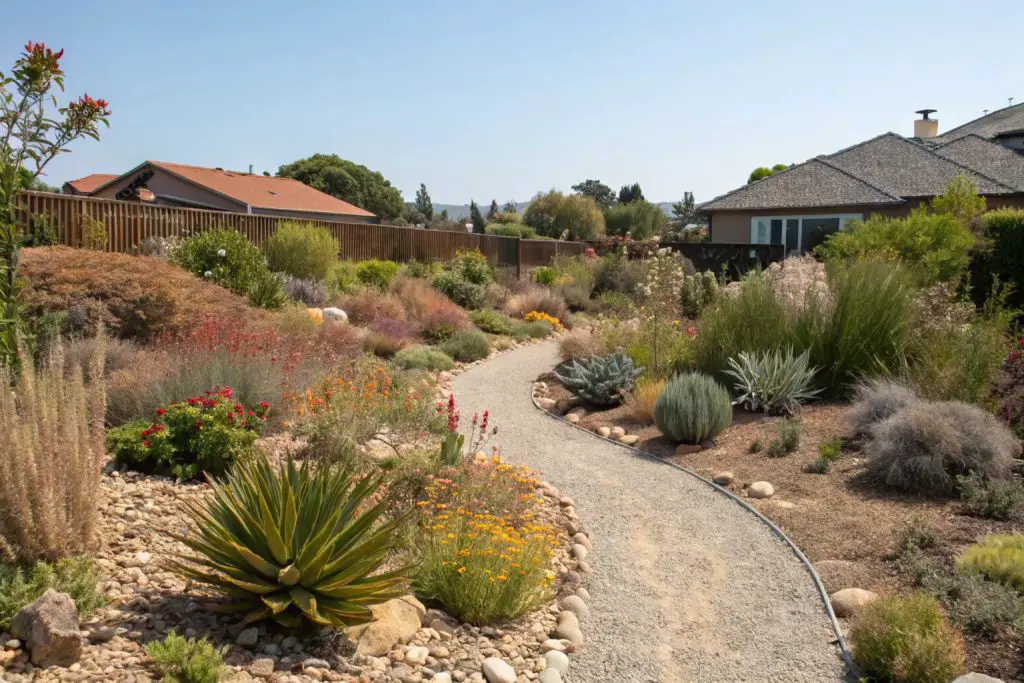
What Is a Dry Garden
A dry garden, also known as a xeriscape or drought-tolerant garden, is a type of garden that is designed to thrive in areas with low rainfall or water scarcity. The goal of a dry garden is to create a beautiful and sustainable outdoor space that requires minimal watering, while still providing a habitat for plants and wildlife.
Characteristics of a dry garden:
- Drought-tolerant plants: Dry gardens feature plants that are adapted to survive with minimal water, such as succulents, cacti, and plants with deep roots.
- Low water usage: Dry gardens use efficient irrigation systems, such as drip irrigation or soaker hoses, to deliver water directly to the roots of plants, reducing evaporation and runoff.
- Well-draining soil: Dry gardens often have soil that is designed to drain quickly, preventing waterlogged soil and root rot.
- Mulch and groundcover: Mulch and groundcover plants help to retain moisture in the soil, suppress weeds, and regulate soil temperature.
- Minimal lawn area: Dry gardens often have minimal or no lawn area, as lawns require frequent watering and maintenance.
Benefits of a dry garden:
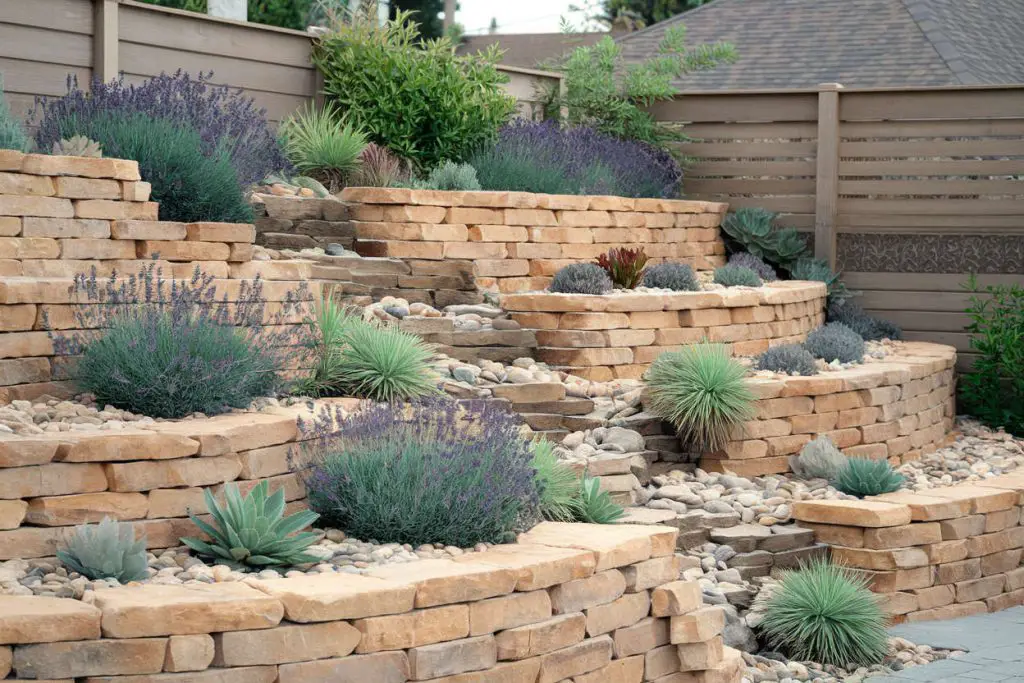
- Water conservation: Dry gardens use significantly less water than traditional gardens, making them ideal for areas with water restrictions or drought-prone regions.
- Low maintenance: Dry gardens require less maintenance, as they are designed to thrive with minimal watering and pruning.
- Increased biodiversity: Dry gardens can provide a habitat for a variety of plants and wildlife that are adapted to dry conditions.
- Unique aesthetic: Dry gardens can be visually striking, with a focus on texture, shape, and color, rather than lush foliage.
Examples of plants that thrive in dry gardens:
- Succulents (e.g., aloe, agave, echeveria)
- Cacti (e.g., prickly pear, saguaro)
- Drought-tolerant grasses (e.g., buffalo grass, blue grama)
- Shrubs (e.g., rosemary, lavender, juniper)
- Groundcover plants (e.g., creeping thyme, sedum, delosperma)
Overall, dry gardens are a great option for gardeners who want to create a beautiful and sustainable outdoor space that requires minimal water and maintenance.
Creating Your Own Dry Garden
Creating your own dry garden is a straightforward task. Below, we’ll walk you through how to accomplish this with a simple step-by-step plan. From understanding your site to choosing the right plants and design principles, this journey will equip you to embrace the beauty and sustainability of dry gardening.
Understanding Your Site
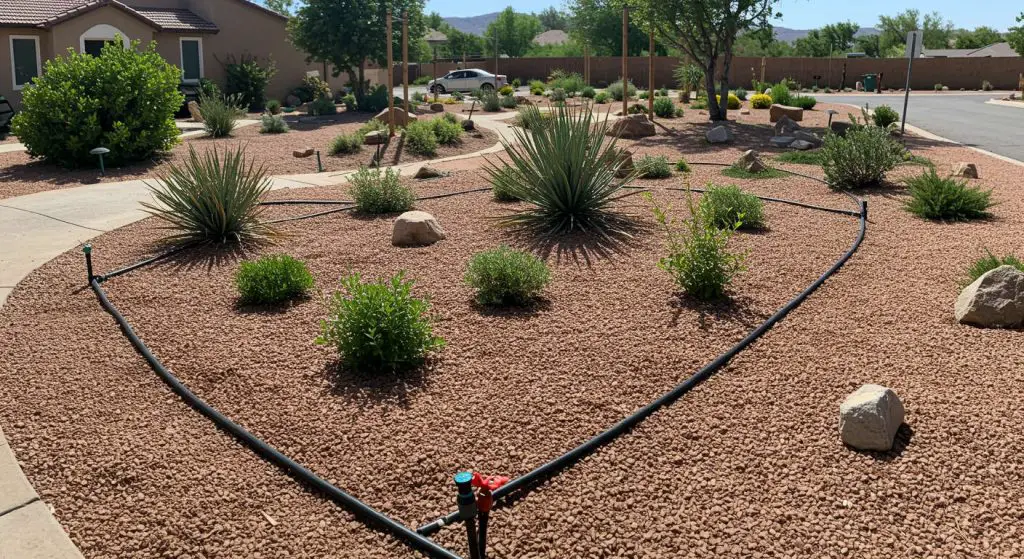
Sunlight
Your first step is to assess the sunlight in your garden. Does it bask in full sun all day, enjoy partial shade, or sit mostly in shadow? This detail will guide your plant choices, as some thrive in intense sun while others prefer filtered light.
Soil Type
Next, determine your soil composition. Sandy soil drains quickly, while clay holds water longer. If your garden doesn’t already have well-draining soil, amending it with materials like gravel or coarse sand is essential for dry gardens. Healthy drainage prevents root rot and encourages strong plant growth.
Microclimates
Identify microclimates within your space. Sheltered spots might retain heat, while exposed areas face harsher conditions. Microclimates allow for creative design, as you can group plants according to their preferred environment.
Existing Landscape Features
Finally, evaluate existing elements such as trees, walls, or pathways. These features can influence your garden’s layout by providing shade or framing focal points. Use them as a foundation to create a cohesive and harmonious design.
Design Principles for Dry Gardens
Xeriscaping Principles
Dry gardening thrives when built on xeriscaping principles. These include:
- Planning and design: Map out your garden to maximize efficiency.
- Soil improvement: Focus on creating well-draining, nutrient-rich soil.
- Efficient irrigation: Minimize water use with drip systems or soaker hoses if needed.
- Plant selection: Choose drought-tolerant varieties suited to your climate.
- Mulching: Use materials like gravel or bark to retain moisture.
- Turf reduction: Replace thirsty lawns with plants or hardscape elements.
- Maintenance: Keep it simple with occasional weeding and pruning.
Hardscaping Elements
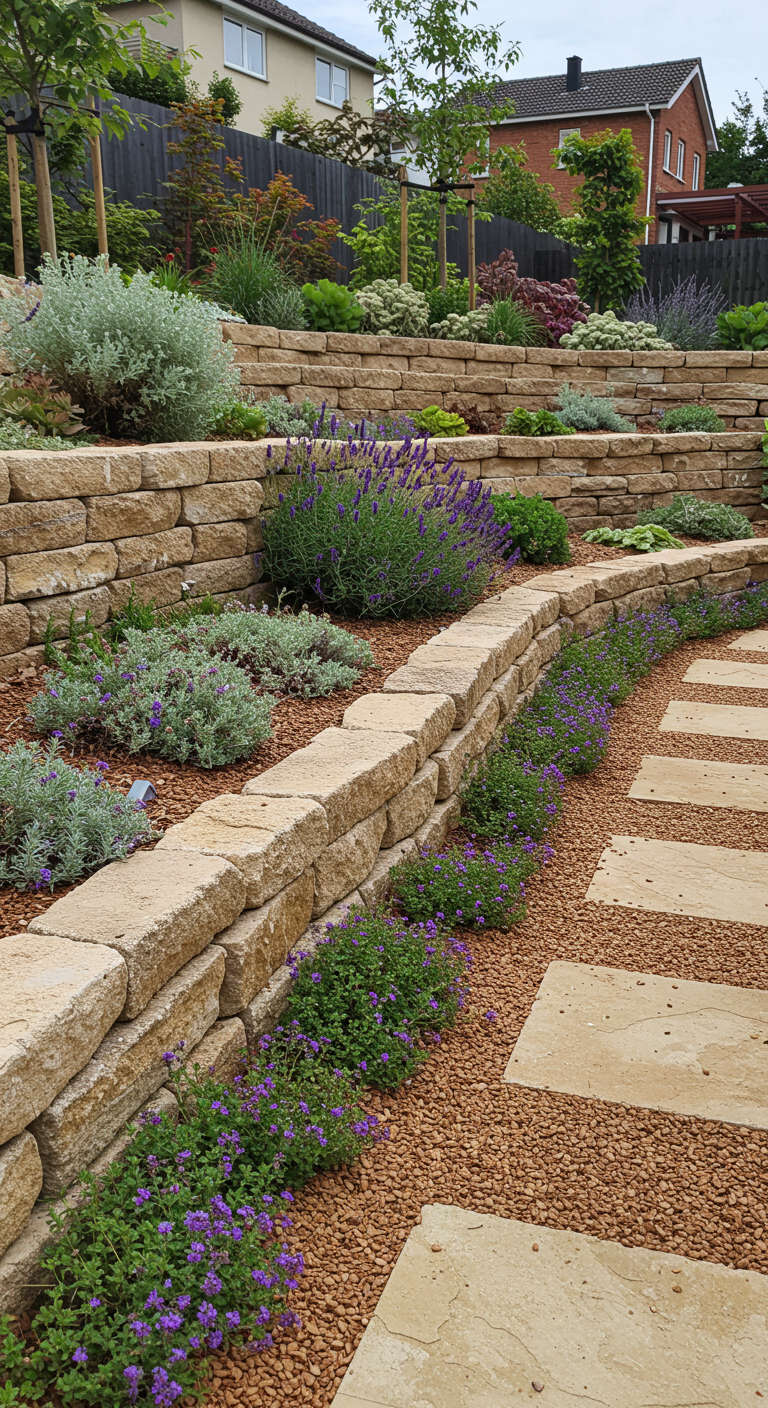
Hardscaping plays a vital role in defining your dry garden’s structure while minimizing water use. These non-living components are both practical and aesthetic, creating visual anchors and pathways. Here’s how to incorporate them:
- Pathways: Use permeable materials like gravel, decomposed granite, or stepping stones to allow water infiltration while providing easy access through the garden. Curved pathways can soften the overall design, while linear paths lend a modern and minimalist touch.
- Retaining Walls: Retaining walls are excellent for managing slopes, preventing erosion, and creating terraces for planting. Use materials like stone, wood, or concrete to match the garden’s style. Natural stones often blend seamlessly with drought-tolerant landscapes.
- Rock Features: Add rock clusters or boulders to mimic natural arid landscapes. These elements can serve as focal points, define garden zones, or provide shelter for heat-loving plants.
- Patios and Seating Areas: Incorporate a small patio or seating area made from flagstone or pavers. Pair it with drought-tolerant container plants to create a welcoming space.
- Decorative Elements: Use sculptures, water features with recirculating systems, or metal art to add a personalized touch. Choose elements that withstand sun and heat to complement your garden’s resilience.
Creating Visual Interest
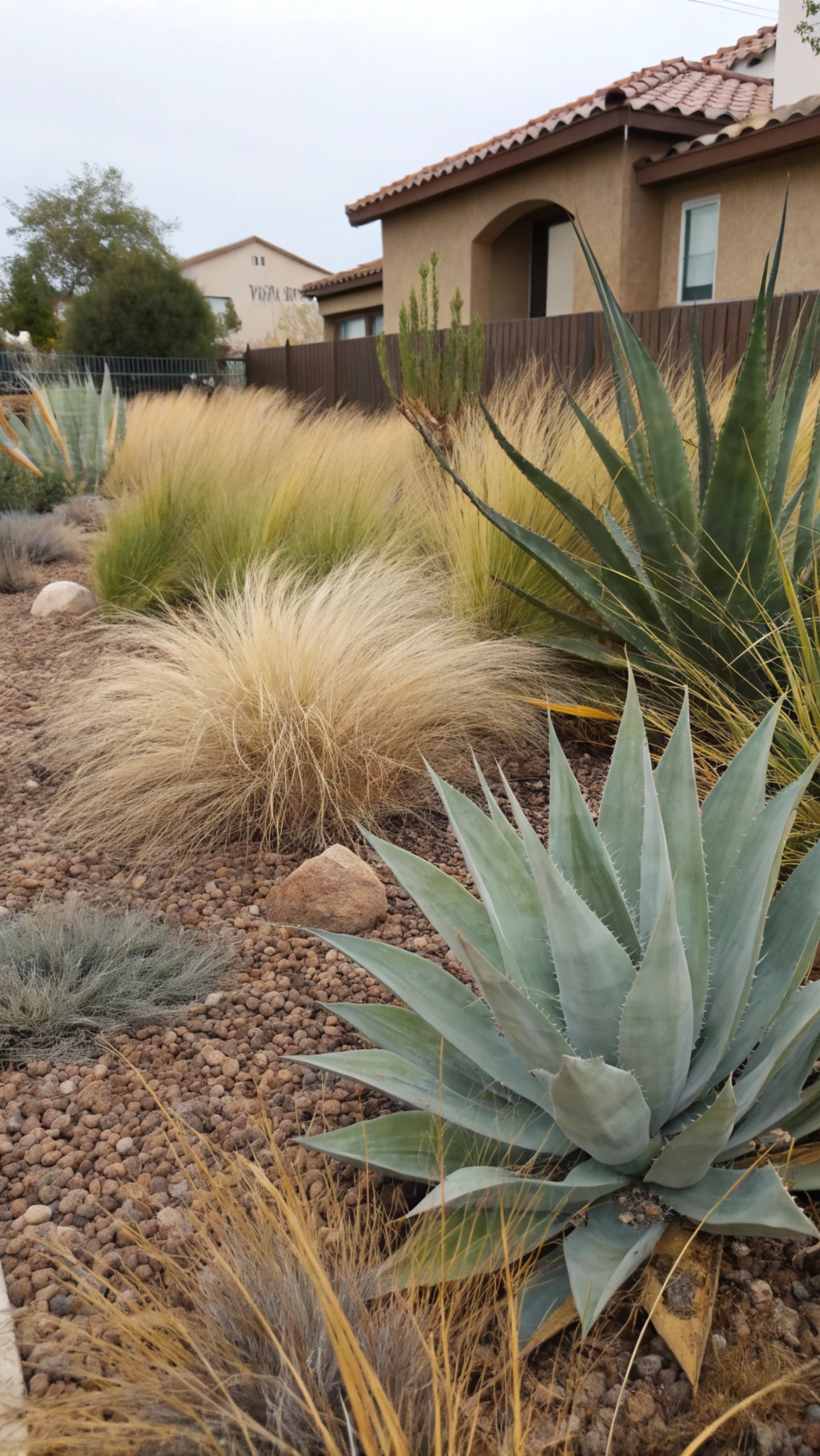
A well-designed dry garden relies on layers of visual appeal to captivate the eye. Here are strategies to elevate your garden’s aesthetics:
- Texture: Combine plants with varying textures to add depth. For instance, spiky agaves can contrast beautifully with soft, flowing ornamental grasses. Gravel or mulch can also provide a tactile contrast to lush greenery.
- Form: Mix upright, sprawling, and compact plant shapes to avoid monotony. Pair vertical plants like yucca or ocotillo with spreading groundcovers like creeping thyme for dynamic layering.
- Color: Introduce color through foliage, flowers, and even hardscaping materials. Use succulents with vibrant hues, such as blue-gray echeverias or purple aeoniums, alongside blooming perennials like lavender or blanket flower.
- Seasonal Interest: Plan for year-round appeal by selecting plants that offer different seasonal highlights. Use evergreens for consistent structure and mix in flowering plants, fruiting cacti, or those with striking seed pods for added interest throughout the year.
- Contrast and Harmony: Play with contrasting elements, such as pairing bold architectural plants with delicate wildflowers. At the same time, maintain a sense of harmony by sticking to a cohesive color palette or repeating key design elements throughout the garden.
Plant Selection: The Heart of a Dry Garden
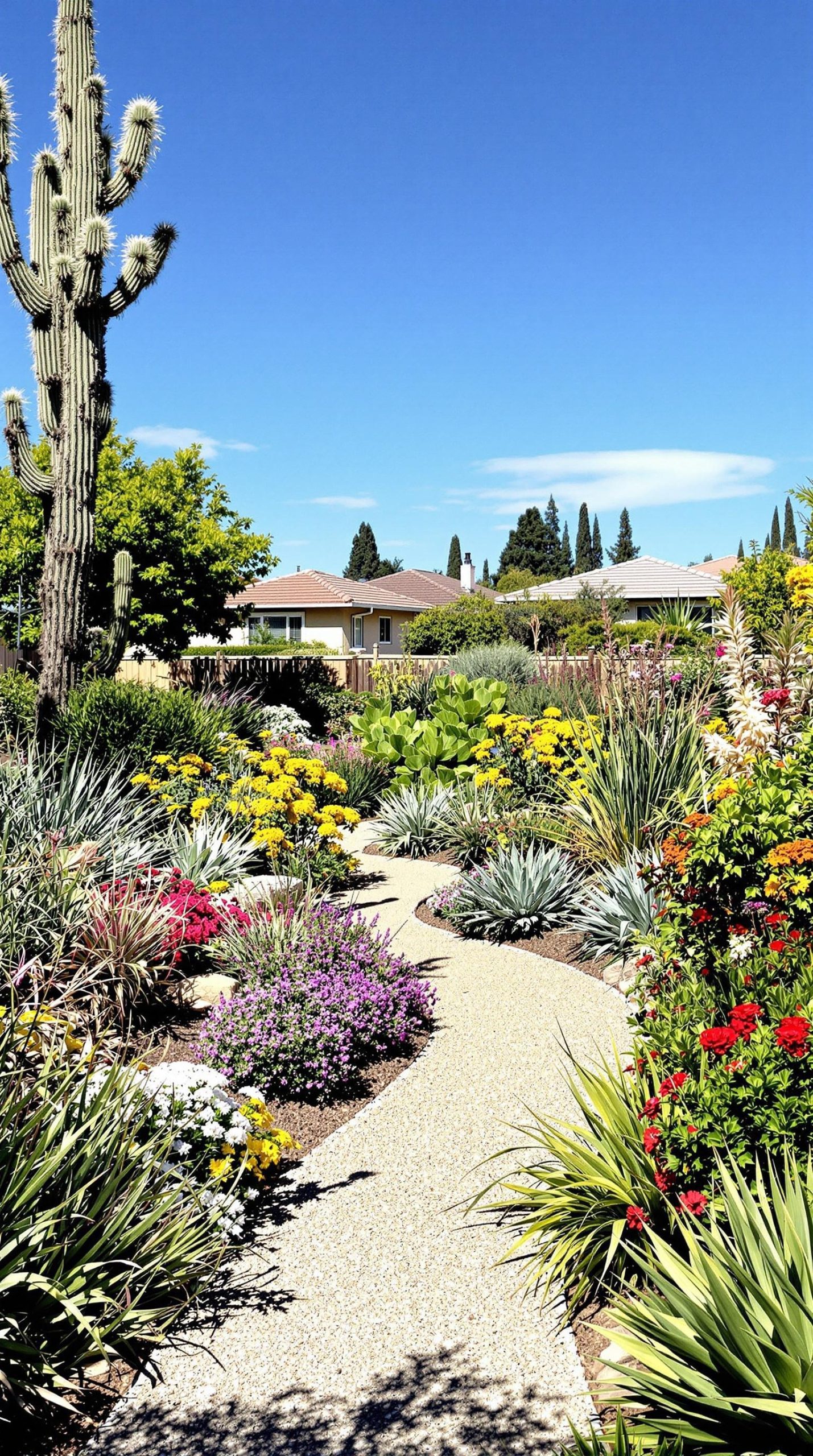
Choosing the right plants is essential to a successful dry garden. Drought-tolerant plants come in many forms—trees, shrubs, groundcovers, succulents, and grasses—offering endless possibilities for creativity.
Focus on Drought-Tolerant Plants
Here’s a list of popular options for dry gardens, categorized by type:
- Trees:
- Palo Verde (Parkinsonia spp.): Bright green bark and yellow flowers.
- Olive Tree (Olea europaea): Mediterranean favorite with silver-gray foliage.
- Shrubs:
- Texas Ranger (Leucophyllum frutescens): Compact shrub with purple flowers.
- Rockrose (Cistus spp.): Low-maintenance with pink or white blooms.
- Perennials:
- Russian Sage (Perovskia atriplicifolia): Lavender blooms on silvery stems.
- Salvia (Salvia spp.): Vibrant flowering options in many colors.
- Groundcovers:
- Sedum (Sedum spp.): Succulent groundcovers in various hues.
- Creeping Thyme (Thymus serpyllum): Aromatic with tiny purple flowers.
- Succulents and Cacti:
- Agave (Agave spp.): Striking architectural plants.
- Barrel Cactus (Echinocactus grusonii): Compact, globe-shaped cactus.
- Grasses:
- Blue Fescue (Festuca glauca): Mounded, blue-green tufts.
- Muhly Grass (Muhlenbergia capillaris): Airy plumes of pinkish flowers.
Highlight Specific Plant Characteristics
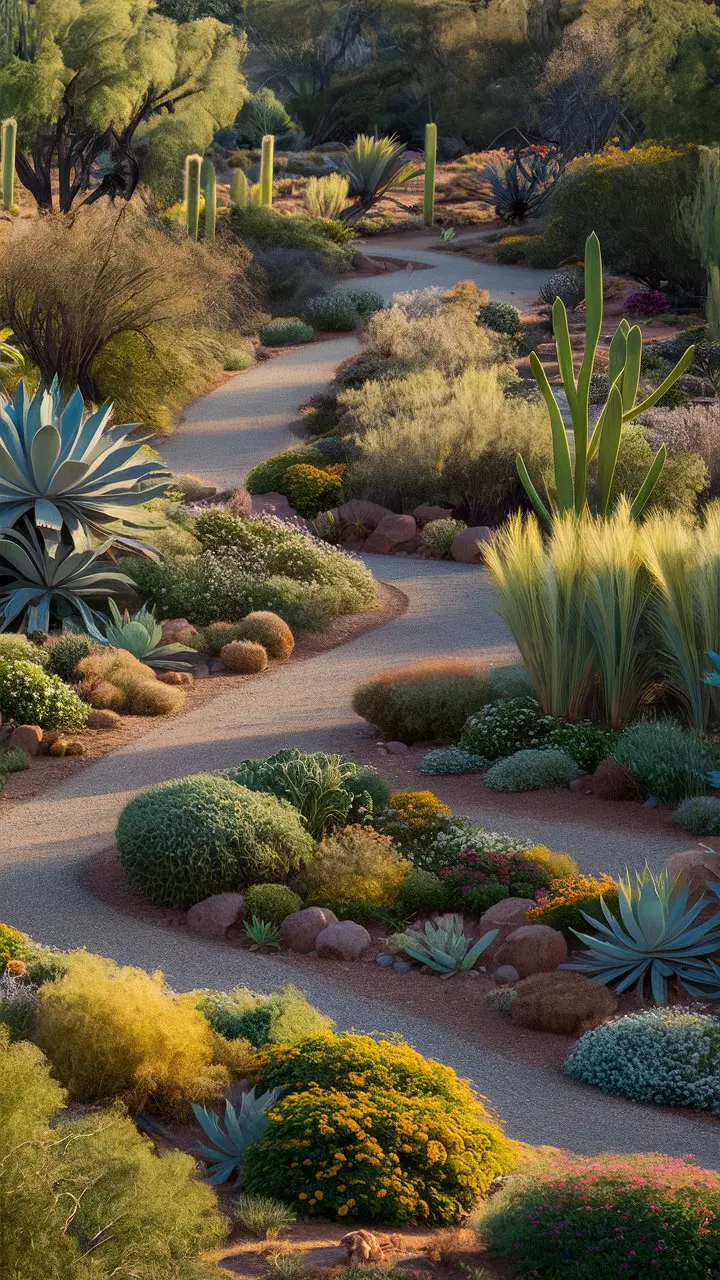
When choosing plants for a dry garden, focus on their unique characteristics to create a visually engaging and sustainable landscape.
Size and Growth Habit
Consider how large each plant will grow and its shape. For example:
- Small plants: Creeping thyme or sedums work well as groundcovers or fillers between hardscape elements.
- Medium-sized plants: Russian sage and salvia create eye-level interest with their colorful blooms and upright growth.
- Large plants: Agaves or olive trees provide dramatic focal points or shade.
Be mindful of the space you’re working with and ensure plants have enough room to reach their full potential without overcrowding.
Bloom Time
Maximize year-round appeal by selecting plants with staggered bloom times:
- Spring bloomers: Rockrose or California poppies can bring early color to your garden.
- Summer favorites: Lavender and blanket flowers provide vivid hues during the warmer months.
- Fall and winter interest: Choose grasses like muhly grass, which offers striking plumes, or succulents that maintain vibrant foliage throughout colder seasons.
Color and Texture
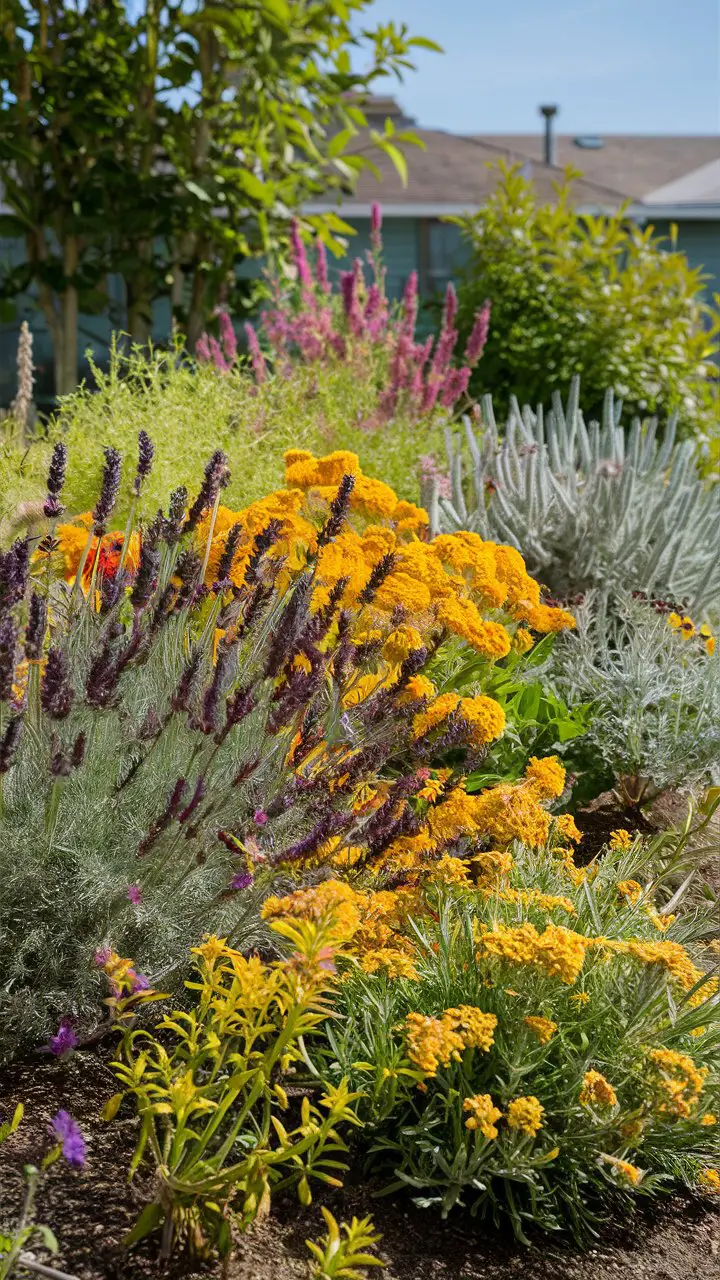
Use a mix of colors and textures to add depth and intrigue:
- Foliage: Pair silver-toned plants like lamb’s ear with darker greens for contrast.
- Flowers: Add bold pops of color with drought-tolerant perennials like echinacea or gaillardia.
- Texture: Combine smooth-leaved succulents with feathery ornamental grasses for a balanced look.
Drought Tolerance and Maintenance
Select plants with varying levels of drought tolerance to match microclimates in your garden. For high-maintenance areas, choose hardy plants like yucca or cacti. For spots needing less attention, use creeping groundcovers like thyme or sedum.
Showcase Plant Combinations
Creating thoughtful plant pairings enhances both the beauty and functionality of a dry garden. Consider these combinations for inspiration:
Contrasting Textures
- Pair spiky agave with soft, billowing muhly grass. The architectural structure of the agave contrasts beautifully with the airy plumes of grass.
- Use succulents like echeveria alongside gravel beds to emphasize their smooth, sculptural forms.
Harmonizing Colors
- Mix blue-gray foliage plants like blue fescue or Russian sage with purple or lavender flowers for a cool-toned, calming effect.
- Combine vibrant orange blanket flowers with yellow coreopsis for a cheerful, warm palette.
Layered Heights
- Group low-growing sedum at the base of taller plants like salvia or penstemon for a tiered effect.
- Use medium-height shrubs like Texas ranger as a backdrop for shorter blooming plants, creating visual depth.
Seasonal Appeal
- Blend evergreens like junipers with seasonal bloomers such as California poppies for year-round interest.
- Pair winter-blooming succulents with grasses that change color in fall, like blue oat grass, to extend your garden’s seasonal charm.
Functionality
- Plant rosemary near pathways for fragrance and visual interest, paired with creeping thyme as a durable groundcover.
- Use yucca and ornamental grasses to stabilize slopes, combining beauty with erosion control.
If you spend time combining plants thoughtfully, you can create a cohesive, visually stunning dry garden that thrives with minimal water and effort. These strategies ensure your garden is as practical as it is beautiful.
Soil Preparation and Planting
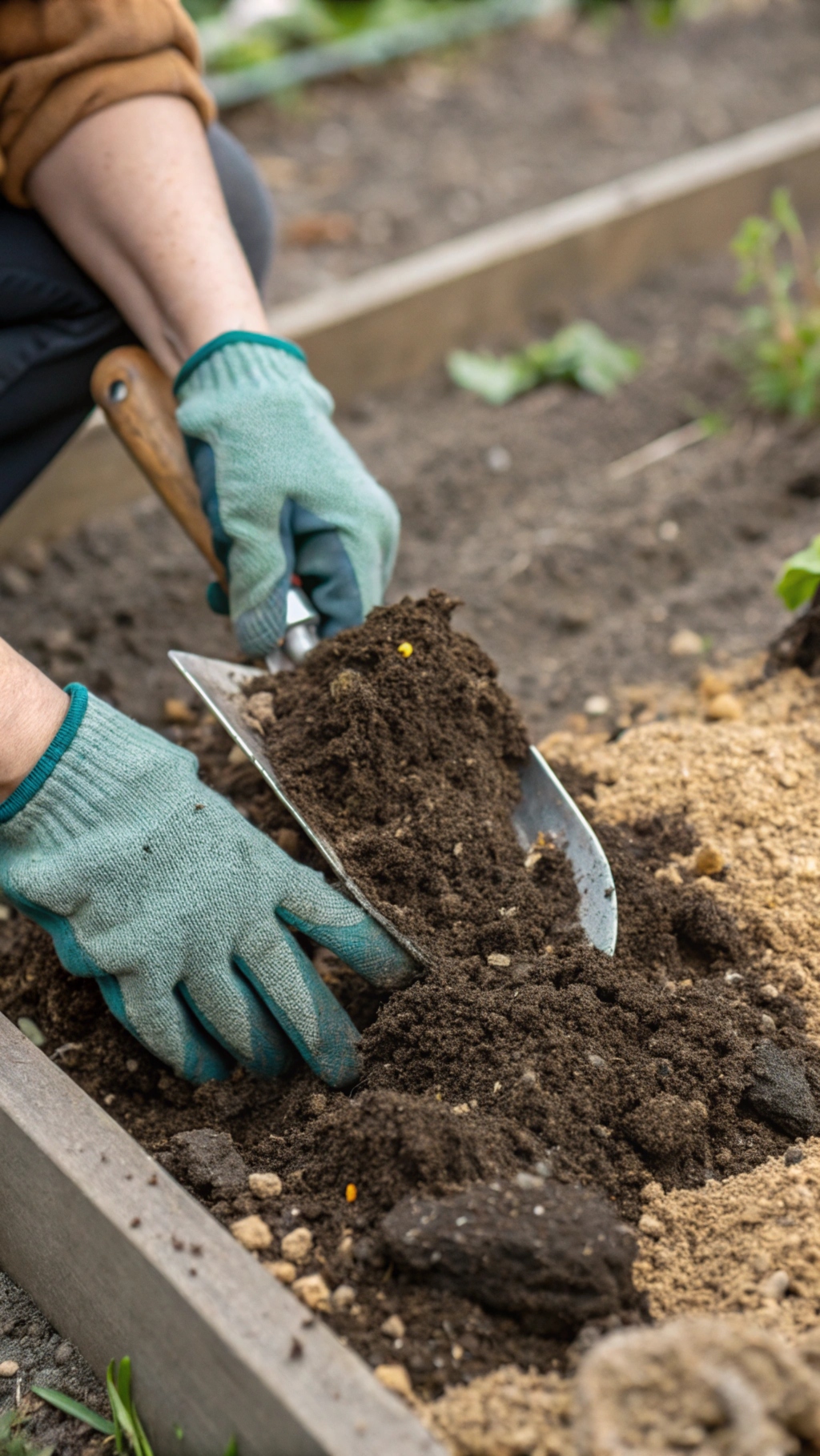
Preparing the soil and planting correctly are crucial steps in establishing a thriving dry garden. These steps ensure your plants receive the drainage, nutrients, and stability they need to grow with minimal water.
Soil Amendments
Dry gardens require well-drained soil to prevent water from pooling around plant roots, which can cause rot. Begin by analyzing your existing soil type:
- Sandy soils: These drain quickly but may lack nutrients. Add organic compost to enrich the soil while maintaining its drainage properties.
- Clay soils: Clay retains too much water and can suffocate plant roots. Improve aeration and drainage by incorporating coarse sand, gravel, or decomposed granite. Gypsum can also be used to help break up heavy clay.
- Loamy soils: These are ideal for dry gardens, offering a balance of drainage and nutrient retention. Light amendments like compost or gravel can optimize conditions for specific plants.
Test the soil’s pH to ensure it’s suitable for the plants you plan to use. Most drought-tolerant plants thrive in slightly acidic to neutral soil (pH 6.0-7.5). Adjust pH levels if necessary using lime (to raise pH) or sulfur (to lower it).
Soil Grading and Contouring
Incorporate grading or contouring to manage water flow effectively. Slight slopes or berms can guide rainwater to areas where it’s needed most while preventing pooling. Swales—shallow ditches lined with gravel or plants—can help collect and redirect rainwater, ensuring even distribution throughout the garden.
Planting Techniques
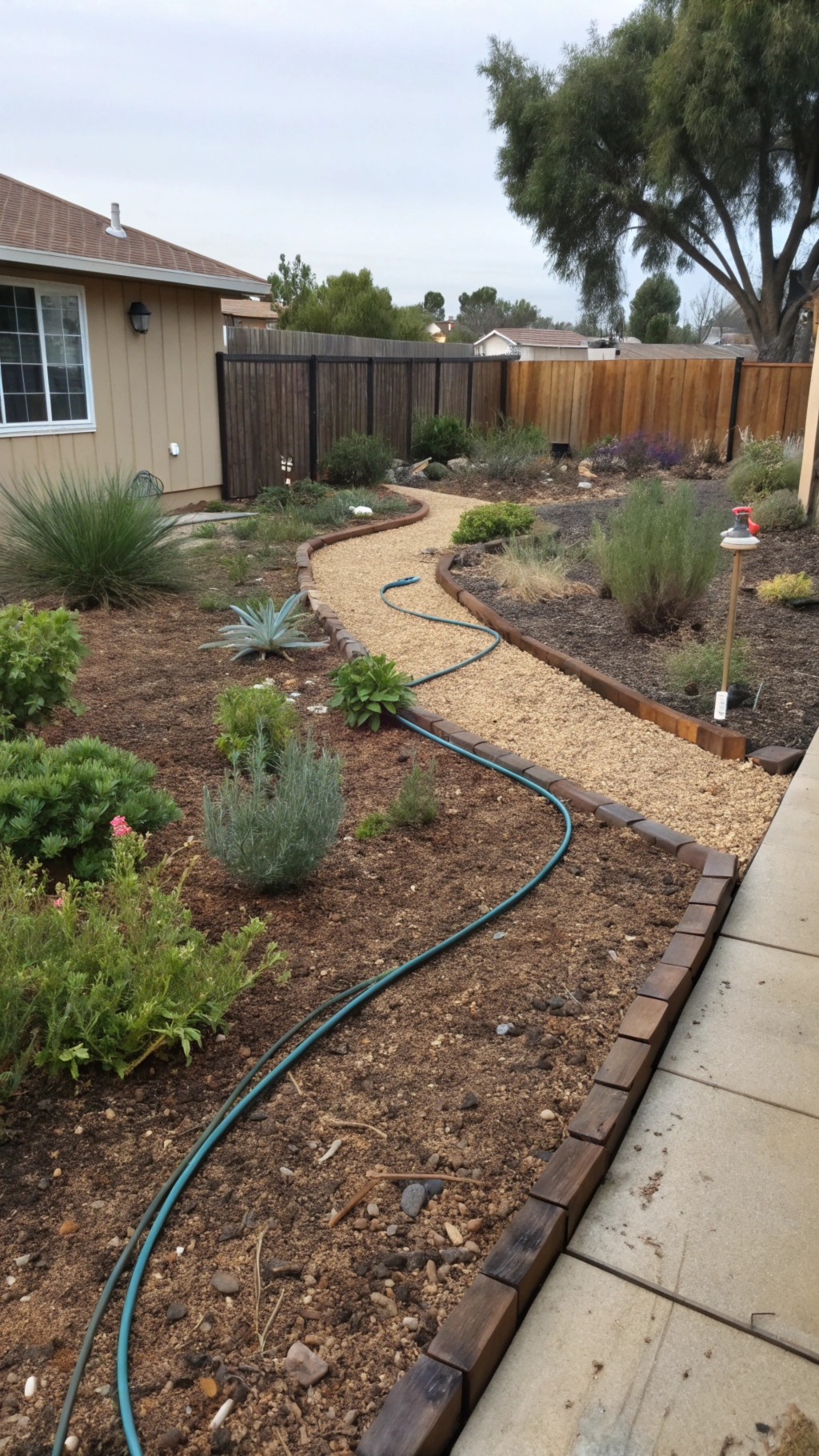
Proper planting ensures your drought-tolerant plants can adapt quickly and grow strong. Follow these guidelines for success:
- Prepare the planting hole: Dig a hole twice as wide as the plant’s root ball but only as deep as its height. This prevents the plant from sinking over time.
- Inspect the roots: Gently loosen or trim the roots if they are tightly wound around the root ball. This encourages them to grow outward into the surrounding soil.
- Plant at the correct depth: Position the plant so the crown (where the stem meets the roots) sits slightly above ground level. This helps prevent water from accumulating around the base of the plant.
- Backfill with amended soil: Use the soil mixture you prepared earlier to fill the hole, pressing gently to remove air pockets without compacting it too tightly.
- Water thoroughly: Even drought-tolerant plants need a good initial soak to help settle the soil and establish roots.
Proper Spacing
Spacing is critical in dry gardens to reduce competition for water and nutrients. Check the mature size of each plant and provide enough room for growth. Crowded plants may struggle to thrive and can invite pests or diseases.
Mulching
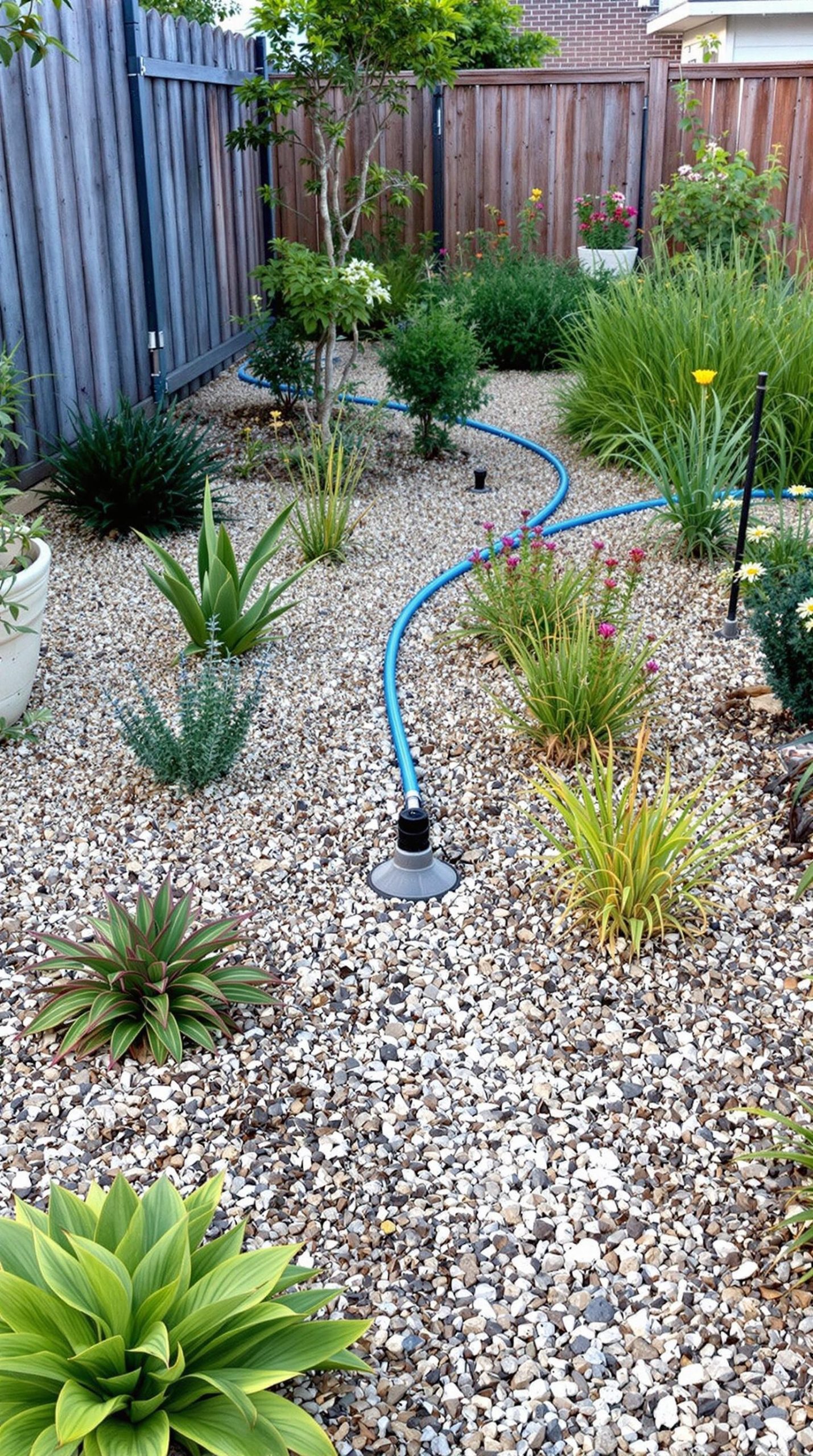
Mulch is a powerful tool in any dry garden, serving several essential functions:
- Conserving moisture: Mulch reduces water evaporation from the soil surface.
- Regulating soil temperature: It keeps roots cool in summer and insulates them in winter.
- Suppressing weeds: A layer of mulch helps block sunlight from reaching weed seeds, reducing their growth.
Choose mulching materials that complement the garden’s aesthetic and function effectively:
- Gravel or stone mulch: Ideal for arid landscapes, these materials add a natural look and provide excellent drainage.
- Bark chips or wood mulch: These are suitable for Mediterranean-style gardens and gradually decompose to enrich the soil. Avoid using them near plants prone to rot.
- Decomposed granite: This option combines functionality with a polished appearance, perfect for modern dry gardens.
Apply mulch to a depth of 2–4 inches, ensuring it doesn’t touch plant stems to prevent rot and pests.
Seasonal Considerations for Planting
Planting during the right season is critical for drought-tolerant plants:
- Cooler months (fall or early spring): These seasons are ideal for planting as cooler temperatures and occasional rain allow plants to establish roots before the stress of summer heat.
- Avoid peak summer heat: Planting during hot months increases stress on new plants and may require more frequent watering.
Irrigation (or Lack Thereof)
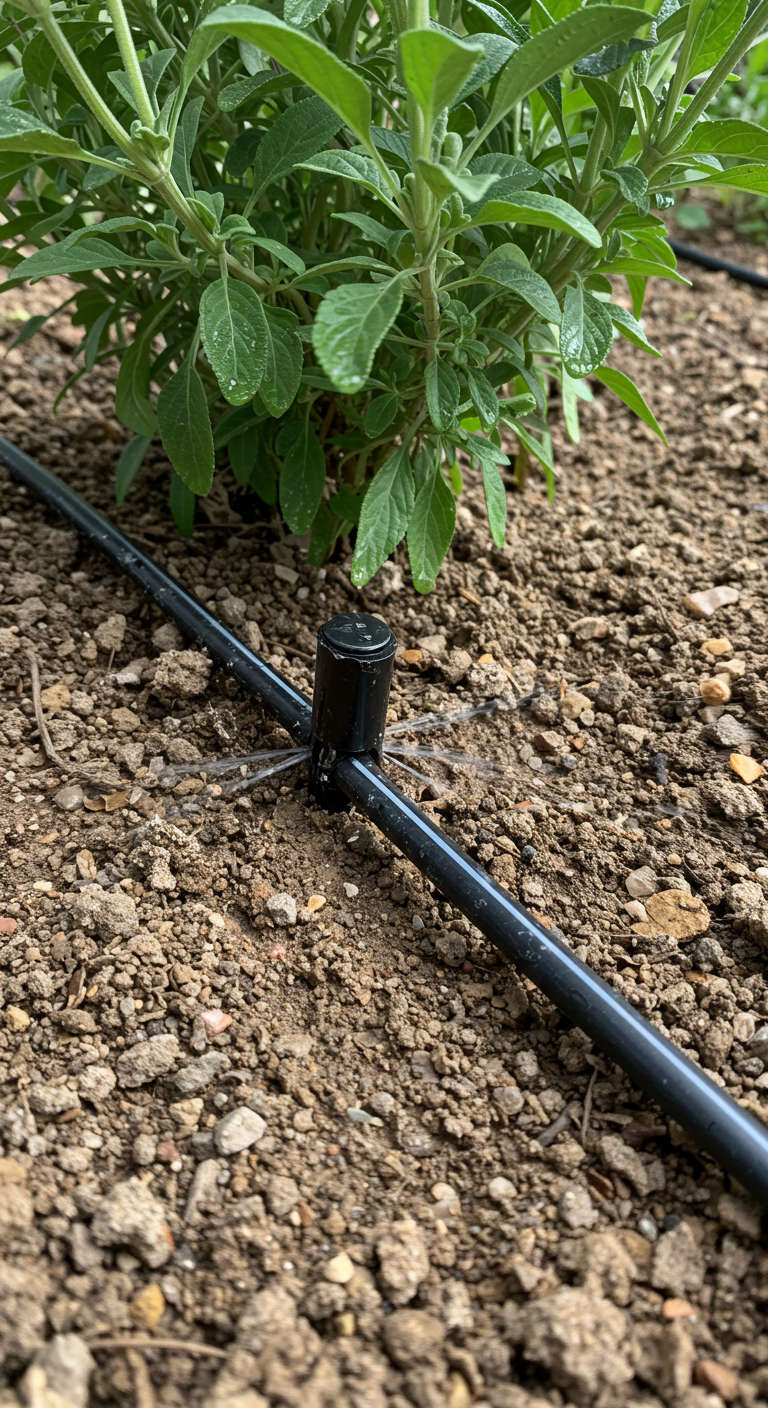
Watering During Establishment
While mature dry gardens require minimal watering, newly planted gardens need extra care during the establishment phase. Drought-tolerant plants often have shallow root systems initially and must develop deeper roots to access water effectively.
- Initial watering: Water plants immediately after planting to help settle the soil and remove air pockets around the roots.
- First few months: Water deeply once or twice a week, depending on your climate, to encourage deep root growth. Adjust the frequency based on rainfall or the plant’s response.
This phase typically lasts 6–12 months, after which most plants can rely on natural rainfall or occasional supplemental watering.
Efficient Irrigation Methods
Even if your dry garden requires occasional watering, choose efficient irrigation systems to minimize water use:
- Drip irrigation: This method delivers water directly to the base of plants, reducing evaporation and ensuring roots receive adequate moisture.
- Soaker hoses: These porous hoses distribute water slowly along their length, making them ideal for hydrozoned areas.
- Rainwater harvesting: Use barrels or cisterns to collect and store rainwater for irrigating your garden naturally.
Install a timer on irrigation systems to regulate watering schedules and avoid overwatering.
Watering Frequency and Timing
For established dry gardens, follow these guidelines to maintain plant health:
- Deep, infrequent watering: Water deeply once every few weeks, allowing moisture to penetrate the soil and encourage roots to grow downward. Avoid shallow, frequent watering, which promotes surface roots.
- Early morning or evening: Water during cooler times of the day to reduce evaporation and help plants absorb moisture effectively.
Minimal to No Irrigation
One of the greatest advantages of dry gardens is their ability to thrive with little or no irrigation. Many drought-tolerant plants are adapted to arid conditions, relying on natural rainfall for survival. Over time, established plants require only occasional watering during extended droughts.
Maintenance
Dry gardens are designed for low-maintenance care, making them ideal for busy gardeners. However, some routine tasks are necessary to keep them looking their best:
Weeding
Regular weeding is essential, especially in the early stages. Mulch helps suppress weed growth, but occasional hand-weeding will ensure they don’t compete with your plants for water and nutrients.
Pruning
Pruning maintains the health and shape of your plants:
- Remove dead or damaged branches to encourage new growth.
- Shape shrubs or perennials for a tidy appearance, especially those with sprawling or woody growth habits.
- Cut back flowering plants like salvia or Russian sage after blooms fade to promote a second flush of flowers or prepare them for the next season.
Fertilizing
Most drought-tolerant plants require little to no fertilization, as excessive nutrients can encourage lush growth that is not sustainable in arid conditions. If necessary, apply a light dose of slow-release fertilizer in spring, or use compost to provide gentle nourishment.
Seasonal Cleanup
Adapt your maintenance routine to the seasons:
- Winter preparation: Clear away debris, such as fallen leaves or dead stems, that could harbor pests or diseases. In cold climates, protect tender succulents or young plants with frost cloth.
- Summer preparation: Prune plants lightly in late spring to maintain airflow and reduce heat stress. Ensure mulch is replenished to conserve soil moisture.
Creative Ideas for Dry Gardens
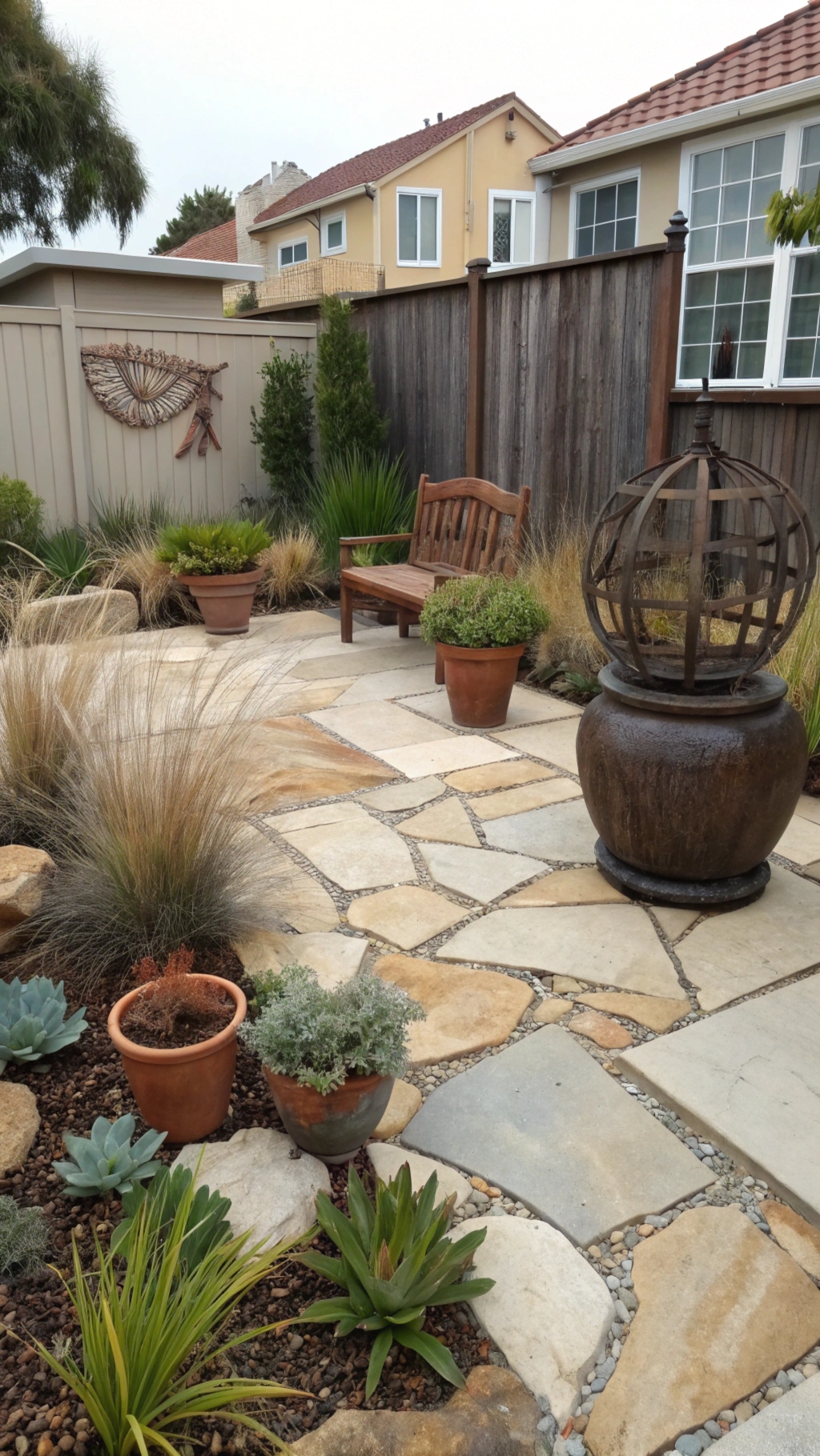
Dry gardens offer endless opportunities for creativity. Beyond plants and hardscaping, you can personalize your garden with artistic touches, focal points, and themed designs.
Incorporating Art and Sculpture
Adding art or sculptures transforms your dry garden into a unique, personalized space. Consider:
- Metal sculptures: Weather-resistant metal pieces, like abstract designs or nature-inspired figures, blend beautifully with drought-tolerant plants.
- Ceramic or terracotta pots: Use colorful or textured pots to introduce pops of color and variety. Group them at different heights for visual interest.
- Natural stone features: Arrange boulders or stone carvings to reflect the rugged beauty of arid landscapes.
Place these elements strategically to draw attention to key areas or complement your garden’s overall design.
Creating a Focal Point
A strong focal point anchors the garden and provides visual interest. Some ideas include:
- Water features: Add a recirculating fountain or birdbath for a serene, cooling effect. Use minimal water to stay true to the dry garden’s principles.
- Fire pits: A fire pit creates a warm gathering space and serves as a dramatic centerpiece. Surround it with drought-tolerant seating plants like succulents or grasses.
- Unique plant arrangements: Showcase a standout specimen, like a large agave or blooming cactus, as a natural focal point.
Themed Dry Gardens

A themed garden ties your design together and adds personality. Consider these ideas:
- Desert-inspired garden: Use cacti, succulents, and gravel with warm-toned hardscaping to replicate the charm of the desert.
- Mediterranean garden: Incorporate olive trees, rosemary, and lavender alongside terracotta pots and stone pathways.
- Modern minimalist garden: Focus on clean lines, geometric plantings, and monochromatic colors for a sleek, contemporary look.
These themes can reflect your personal style and help unify your garden’s design.
Final Thoughts
Dry gardening combines beauty, sustainability, and practicality in one incredible package. By choosing the right plants, understanding your site, and using thoughtful design principles, you can create a stunning garden that thrives with minimal water and maintenance.
The benefits of a dry garden go beyond aesthetics. Lower water bills, less maintenance, and environmental friendliness make this gardening approach ideal for both urban and rural spaces. Whether you’re inspired by desert landscapes, Mediterranean charm, or modern minimalism, there’s a dry garden design for you.
Now is the time to embrace water-wise gardening. Start small, experiment with plants and features, and watch as your garden flourishes in harmony with its environment. Your dry garden will not only conserve resources but also inspire others to join the movement toward sustainable landscaping.
